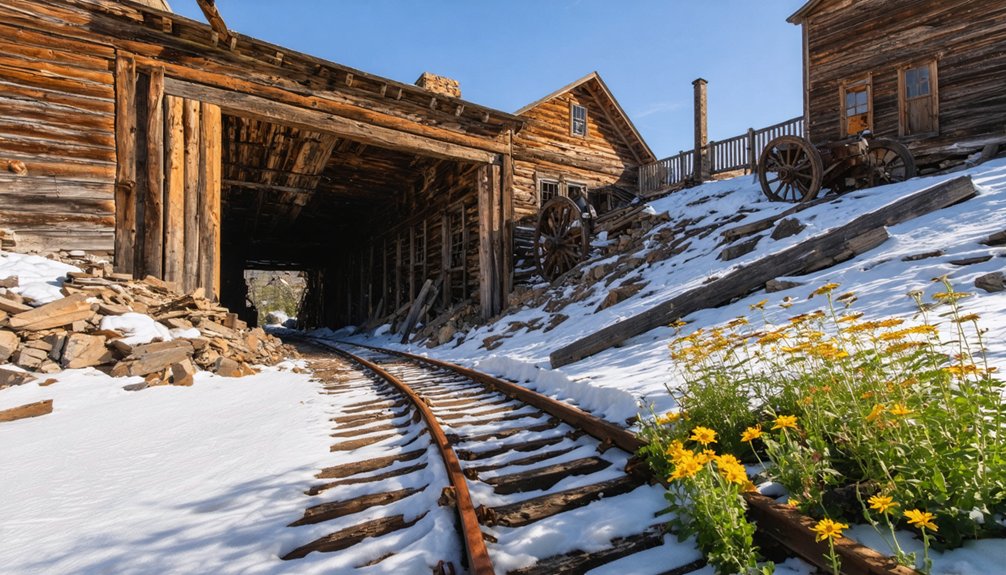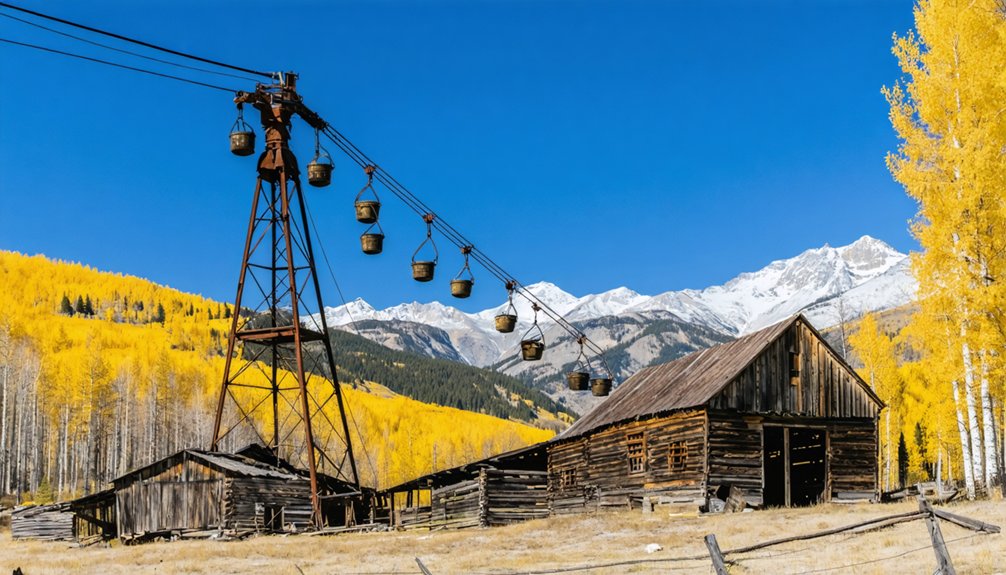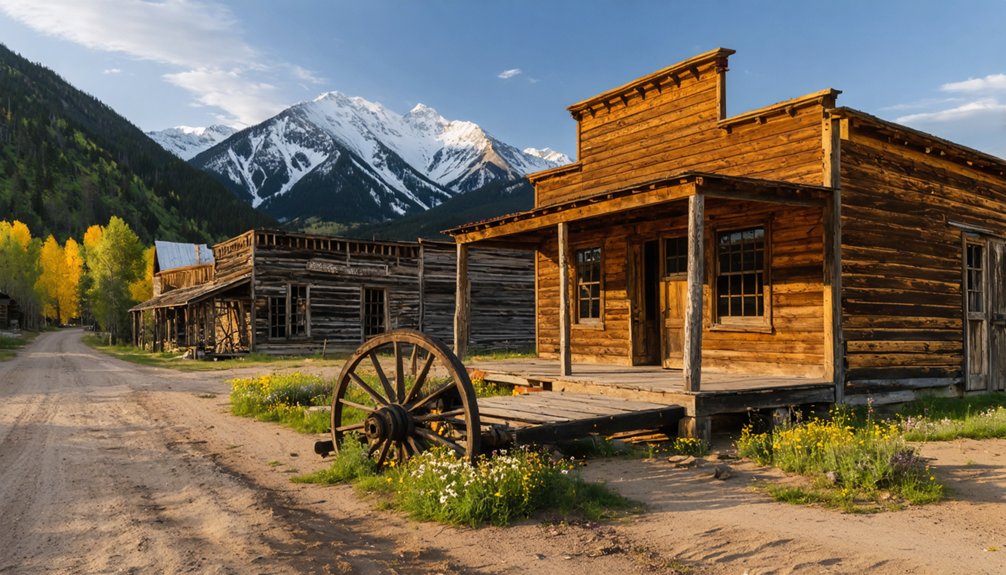Saints John is a ghost town located at 10,700 feet in Summit County, Colorado. Originally called Coleyville, it was established in the 1860s after John Coley’s silver discovery and renamed by Freemasons around 1867. Unlike typical mining towns, it prioritized literacy over alcohol, featuring a library instead of saloons. The Silver Crash of 1893 devastated the community, but three original buildings remain today. The challenging terrain reveals much about this unique mountain settlement’s remarkable history.
Key Takeaways
- Saints John is a former silver mining settlement near Montezuma, Colorado established in the 1860s following John Coley’s silver discovery.
- Named by Freemasons around 1867-1870, the town reached a population of 71 residents and uniquely had a library but no saloons.
- Located at 10,700 feet elevation, residents endured extreme isolation, harsh weather, and seasonal operations due to challenging mountain conditions.
- The Silver Crash of 1893 devastated the community, causing massive unemployment, bank failures, and eventual abandonment.
- Today, three original buildings remain with mining artifacts, accessible via a 1.5-mile trail from Montezuma with significant elevation gain.
From Coleyville to Saints John: The Naming of a Silver Boomtown
While many Colorado mining settlements underwent multiple name changes during their development, Saints John presents a particularly fascinating example of how Masonic influence shaped local identity.
The settlement’s Coleyville origins trace back to the 1860s, named after John Coley who discovered the first silver mine while hunting in the area in 1861.
Around 1867-1870, local Freemasons transformed the community’s identity by renaming it Saints John, honoring both Saint John the Baptist and Saint John the Evangelist. This occurred as the Boston Silver Mining Association purchased the mining claims, marking a significant shift in the town’s development.
Despite its Saints John significance as one of Colorado’s early silver camps, the settlement remained relatively small, with a population of about 71 residents by 1870. The town’s silver mines were highly productive, with the best veins yielding up to $100 per ton. Many miners actually lived in nearby Montezuma while working in Saints John. Similar to other mining towns like Ashcroft and Independence, Saints John faced population decline as the mines became less productive, leading to its eventual abandonment.
Discovering Silver in the Shadow of Glacier Mountain
When prospector John Coley first stumbled upon silver deposits while hunting on Glacier Mountain’s crest around 1863-1864, he couldn’t have anticipated the industrial complex that would soon transform this remote alpine location.
His initial silver discovery utilized primitive mining techniques – smelting galena sulfides in a makeshift furnace with a hollow log flue wrapped in rock and clay.
Far from modern refineries, Coley’s ingenuity transformed raw galena into silver using only logs, rocks, and determination.
Eastern investors quickly recognized the potential of these silver-rich veins. The Boston Silver Mining Association acquired claims by the late 1860s, developing significant infrastructure at this 10,000-foot elevation site. This led to the construction of a new mill in 1872 that enhanced ore processing capabilities.
By 1870, they were extracting substantial quantities of silver-lead ore from the Saint Elmo vein, which measured up to five feet wide.
Despite inefficient processing methods of the era, the site would eventually yield between one and five million dollars in ore.
The town was initially called Coleyville but later renamed Saints John, which was unique among mining settlements for having a public library instead of a saloon.
Life at 10,000 Feet: Challenges of Mountain Mining
If you’d visited Saints John during its mining heyday, you’d have confronted the brutal realities of surviving at 10,000 feet, where temperatures rarely climbed above freezing and snowfall often exceeded 200 inches annually.
Your existence would have been defined by extreme isolation, with treacherous mountain roads frequently impassable and essential supplies like food and medicine arriving sporadically at best.
You’d have labored in primitive mines without modern safety equipment, facing daily threats from cave-ins, toxic gases, and altitude sickness while extracting silver from the unforgiving mountain. The miners’ constant exposure to acid mine drainage created lasting environmental contamination that persists in the area today. These operations extracted critical minerals that would today be considered essential for national security and technology development, according to modern geological surveys.
Weather and Survival
Situated at a breathtaking elevation of nearly 10,700 feet on Glacier Mountain, Saints John presented miners with extraordinary challenges beyond the typical hardships of mineral extraction.
Weather patterns were merciless, with freezing temperatures possible any day of the year and brutal winds sweeping across the exposed mountainside.
To survive these harsh conditions, residents developed specific techniques:
- Many miners chose to live in lower-elevation Montezuma, commuting to Saints John only for work shifts.
- Operations followed strict seasonal schedules, maximizing productivity during brief summer months.
- Local processing facilities reduced dangerous downhill transport during icy conditions.
- Shelters were built for function rather than comfort, prioritizing protection from extreme elements.
The thin mountain air further complicated daily existence, reducing stamina and requiring additional rest periods during physically demanding mining activities.
Visitors hiking the area today can still witness the switchbacks up the west face of Glacier Mountain that miners traversed daily.
The steep 1,698 ft elevation gain from Montezuma to the ridge above made daily travel physically demanding even for the hardiest miners of the era.
Isolation and Supply
Life at the remote Saints John mining outpost required extraordinary measures to overcome severe geographic isolation. Perched at nearly 10,000 feet, you’d face broken supply chains and significant logistical challenges when acquiring necessities.
With no agriculture possible at this elevation, all food had to be transported over rough mountain roads often impassable during winter months. You’d rely on infrequent deliveries from lower elevations, necessitating careful stockpiling before heavy snows. The Boston Silver Mining Association established crucial supply routes that supported the town’s development during its peak years. Similar to towns like St. Elmo, residents constructed wooden structures that needed to withstand harsh mountain conditions.
Mining operations faced even greater hurdles, with complex systems of tramways and chutes required to move ore through the rugged terrain. The small community (just 71 residents by 1870) lacked formal infrastructure, forcing a self-sufficient lifestyle.
Despite proximity to Montezuma, only 1.5 miles away, the challenging mountain terrain transformed even this short distance into a formidable journey.
Mining Without Technology
Working at Saints John meant confronting the harsh realities of pre-industrial mining techniques while battling the extreme conditions of high-altitude labor. At nearly 10,000 feet, you’d struggle with thin air while performing intense manual labor using only primitive tools like picks and hand drills.
Your daily mining routine would include:
- Extracting ore from narrow 18-inch to 5-foot veins using black powder and muscle power.
- Hoisting ore up shafts manually before lowering it through tramways and chutes.
- Sorting materials by hand with no mechanical assistance or conveyors.
- Maintaining heavy equipment, including 6,000-pound flywheels, using simple pulleys.
Every task demanded physical strength while braving cold temperatures and high winds.
With no modern technology, your productivity depended entirely on human endurance, making work slow, dangerous, and exceedingly difficult.
The Boston Silver Mining Association’s Colorado Venture

When you examine the history of Saints John, you’ll find that eastern capitalists established the Boston Silver Mining Association in the late 1860s, transforming the small mining camp into a more organized operation.
The association quickly demonstrated its industrial ambitions by shipping 6,600 pounds of lead-rich material from their smelting works in 1870 and constructing a new mill in 1872.
This corporate approach to mining represented a significant shift from individual prospecting to organized extraction, with Boston-based financing fueling the development of substantial infrastructure throughout the mountain settlement.
East Coast Financing Arrives
As Colorado’s mining industry took shape in the late 1860s, Eastern capital began flowing westward, transforming fledgling prospector camps into organized mining communities.
In Saints John, this Eastern investment came from Boston capitalists who purchased silver claims and established the Boston Silver Mining Association.
The Boston financiers transformed the settlement through:
- Construction of an initial smelter designed by Cornish engineer John Collom around 1865
- Development of a new mill in 1872 specifically for processing local galena ore
- Introduction of heavy machinery, including a 100-horsepower steam engine
- Financial backing that eliminated costly ore transport to distant facilities
This influx of capital reshaped community development, evolving Saints John from an informal prospector’s camp called Coleyville into a structured mining settlement that soon became Summit County’s most populated place with 71 residents by 1870.
Corporate Mining Operations Begin
The Boston Silver Mining Association emerged as the first organized corporate entity in Saints John during the late 1860s, transforming the nascent mining camp into a structured operation.
These eastern capitalists hired Cornish engineer John Collum to develop innovative mining techniques for processing stubborn galena ore, experimenting with roasting furnaces and smelting methods to increase yields.
A Different Kind of Mining Town: Books Instead of Bourbon
Unlike most boomtown mining settlements of Colorado’s silver rush era, Saints John established itself as a remarkably disciplined community where books took precedence over bourbon.
While neighboring camps drowned in whiskey, Saints John’s miners quenched their thirst with literature instead of liquor.
As a company town owned by the Boston Silver Mining Association, Saints John deliberately created an alternative social environment focused on literacy rather than libations. The town’s library significance stemmed from its collection of approximately 300 voting books housed in the estate office, creating a cultural contrast with neighboring camps like Wild Irishman.
You’ll find four distinct characteristics that defined this unusual mining town:
- No saloons existed, only a well-stocked library.
- The community served adjacent settlements before they developed their own facilities.
- A schoolhouse built around 1870 reinforced educational values.
- Local Freemasons influenced the restrained social atmosphere.
Engineering Marvel: Colorado’s Longest Aerial Tramway

While Saints John drew renown for its literary pursuits, Colorado’s engineering legacy reached new heights with the Estes Park Aerial Tramway, a remarkable feat constructed in 1955 that stands as the state’s longest free-spanning aerial system.
Designed by Robert Heron, a pioneer in mountain transport innovation, this engineering marvel spans 2,630 feet without support towers, rising 1,060 feet up Prospect Mountain. The aerial tramway engineering features 1¼-inch steel cables supporting 25 tons of tension, carrying bright red gondolas that transport 240 passengers hourly.
You’ll experience the five-minute ascent in counterbalanced cars, enjoying panoramic Rocky Mountain views and potential wildlife sightings.
Since its completion for $150,000, the tramway has carried over 3 million visitors, operating seasonally from May through September with recently upgraded amenities including a renovated café.
The Silver Crash of 1893: Beginning of the End
As Colorado’s mining economy reached its zenith in the early 1890s, few could have anticipated the devastating financial collapse that would soon reshape the state’s future.
The repeal of the Sherman Silver Purchase Act triggered an unprecedented economic downturn that decimated the silver market and Colorado’s mining industry.
The Silver Panic of 1893 struck Colorado with devastating force, collapsing fortunes and shattering entire communities overnight.
The crash’s immediate effects were catastrophic:
- Approximately 30,000 miners and smelter workers lost their jobs almost overnight.
- Mining towns experienced unemployment rates of 40-50%, with single-industry settlements nearing 100%.
- Banks failed as panicked customers withdrew savings, causing financial institutions to close.
- Real estate values plummeted while construction halted for over three years.
For Saints John and similar mining communities, this crash represented not just an economic setback, but an existential threat that would ultimately lead to abandonment.
What Remains: Exploring the Ruins Today

What becomes of a mining town after the silver economy collapses and its inhabitants seek fortunes elsewhere? Today, you’ll find just three original buildings standing in Saints John, each exemplifying the rugged historic architecture of Colorado’s mining era.
The superintendent’s home remains remarkably preserved and reportedly occupied.
Beyond these structures, you’ll discover the partially collapsed mill with its prominent smokestack, crumbling foundations of the Home Comfort Hotel along Main Street, and nearby Wild Irishman mining camp ruins.
Environmental hazards persist—toxic water still flows from mine tailings down the mountainside.
Access requires a challenging 4×4 trail, but rewards include photogenic ruins set against mountain scenery.
While exploring, remember these aren’t merely abandoned buildings but open-air artifacts of American frontier ambition.
Seasonal Adventures: Best Times to Visit Saints John
Timing your visit to Saints John requires careful consideration of Colorado’s high-altitude seasonal patterns. At 12,373 feet elevation, this ghost town experiences dramatic seasonal changes that directly impact accessibility and visitor experience.
- Summer (July-September): Prime season with ideal weather, full road access, and comfortable temperatures for exploring ruins and hiking trails.
- Late Spring (June): Roads typically open by May 20, though lingering snow may affect higher elevations.
- Early Fall (October): Spectacular photography opportunities with fall foliage, but prepare for cooler temperatures and potential early snow.
- Winter (November-May): Saints John Road closes November 23 through May 20, making the ghost town largely inaccessible.
Remember that a 4WD vehicle is essential for traversing the rocky terrain beyond creek crossings, regardless of seasonal highlights.
Connecting With History: Trails to Saints John and Wild Irishman
Traversing the historic paths to Saints John and Wild Irishman Mine offers visitors a tangible connection to Colorado’s silver mining legacy while challenging them with rugged alpine terrain.
From Montezuma, you’ll follow FDR 275 approximately 1.5 miles to Saints John, then another 1.5 miles to reach Wild Irishman Mine, climbing nearly 1,000 feet in elevation.
Along this 4WD route, you’ll encounter remarkable historical landmarks from the 1870s silver boom—three original buildings, mill foundations, and miners’ cabins.
Scattered mining artifacts include ore roasting furnaces and abandoned shafts (which you should never enter).
The trail follows Saints John Creek valley before switchbacking up Glacier Mountain’s western slope, where Michael Dulhaney’s Irish-named mine operated until the 1893 silver crash.
The journey rewards you with spectacular views of Grays and Torreys Peaks amid alpine wilderness.
Frequently Asked Questions
Did Any Famous Historical Figures Visit Saints John During Its Heyday?
No historically significant famous visitors have been documented. You won’t find records of nationally known figures visiting Saints John during its mining heyday, as it functioned primarily as a company-operated industrial town.
What Happened to the Public Library’s Book Collection After Abandonment?
You won’t find library preservation efforts documented—most evidence suggests the 300 volumes succumbed to book decay from exposure to mountain elements, vandalism, and natural deterioration after Saints John’s sudden abandonment.
Were There Any Major Accidents or Disasters in Saints John?
Despite three camps being wiped out by a flash flood, you’d find few documented mining accidents in Saints John’s history. The flood, triggered by Michael Dulhaney’s celebratory shout, fuels ghost stories today.
How Did Residents Celebrate Holidays in This Remote Mountain Town?
You’d find holiday traditions centered around company-sponsored events in the library or schoolhouse, with community gatherings featuring communal meals and storytelling to combat isolation during harsh mountain winters.
What Indigenous Peoples Inhabited the Area Before Mining Settlement Began?
You’ll find that primarily the Ute tribe inhabited this land, maintaining rich cultural heritage through seasonal mountain use. They established hunting grounds and spiritual connections long before miners arrived in the area.
References
- https://www.youtube.com/watch?v=gdxUcRnQRPg
- https://westernmininghistory.com/towns/colorado/saints-john/
- https://www.youtube.com/watch?v=6Scpt0m1D-0
- https://www.4x4explore.com/rds/s_rds/sts_john.html
- https://www.uncovercolorado.com/ghost-towns/montezuma/
- https://gotaltitudesite.wordpress.com/2023/12/11/saints-john-and-wild-irishman-mine-montezuma/
- https://kids.kiddle.co/Saints_John
- https://en.wikipedia.org/wiki/Saints_John
- https://www.denver7.com/news/local-news/colorado-ghost-towns-their-past-present-and-future-in-the-rocky-mountains
- https://www.keystoneresort.com/the-mountain/about-the-mountain/keystone-mining-history.aspx



